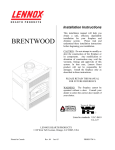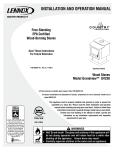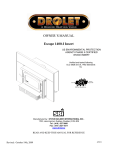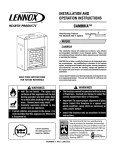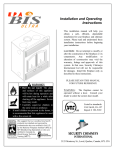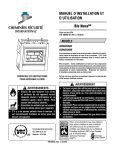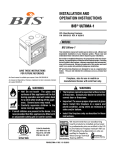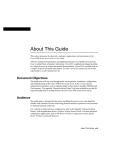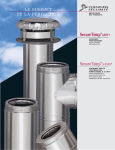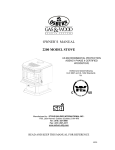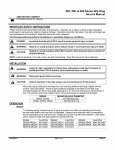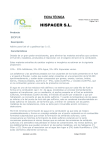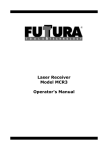Download Magnavox ELITE ME43BKSP User's Manual
Transcript
INSTALLATION AND OPERATION INSTRUCTIONS ME43 43" Wood Burning Fireplaces P/N 850,027M REV. G 04/2008 MODEL ME43BK SP This installation manual will enable you to obtain a safe, efficient and dependable installation of your fireplace system. Please read and understand these instructions before beginning your installation. Do not alter or modify the fireplace or its components under any circumstances. Any modification or alteration of the fireplace system, including but not limited to the fireplace, chimney components and accessories, may void the warranty, listings and approvals of this system and could result in an unsafe and potentially dangerous installation. Lennox™ wood-burning fireplaces are designed for use as a supplemental heater. They are not intended for continuous use as a primary heat source. RETAIN THESE INSTRUCTIONS FOR FUTURE REFERENCE WARNINGS WARNINGS • Hot! Do not touch! The glass and surfaces of this appliance will be hot during operation and will retain heat for a while after shutting off the appliance. Severe burns may result. • Carefully supervise children in the same room as appliance. • The fireplace cannot be operated without a door. Consult your dealer to select the correct door model. • Important! To assure proper alignment of glass doors: Install this fireplace in a square and plumb condition, using shims as necessary at sides and/or bottom. • Install the fireplace only as described in these instructions. Listed to standards: ULC-S610 & UL-127 Report No. 192-5166 PIME43-F REV. 4 IMPORTANT! GENERAL SAFETY PRECAUTIONS. READ AND UNDERSTAND THESE SAFETY RULES BEFORE YOUR FIRST FIRE. WARNING The ME43 fireplace must be installed with an outside air kit intake, which is included with the fireplace WARNING THE FIREPLACE MUST BE OPERATED WITH THE DOORS FULLY OPENED OR DOORS FULLY CLOSED. IF THE DOORS ARE LEFT PARTLY OPENED, GAS AND FLAME MAY BE DRAWN OUT OF THE FIREPLACE OPENING, CREATING RISKS OF BOTH FIRE AND SMOKE. IF THE UNIT IS OPERATED WITH THE DOORS FULLY OPENED, THE FIRE SCREEN MUST BE USED. WARNING NEVER use gasoline, gasolinetype lantern fuel, kerosene, charcoal lighter fluid, naphtha, engine oil or similar liquids to start or “freshen up” a fire in this fireplace. Keep any flammable liquids a safe distance from the fireplace at all times. WARNING THIS FIREPLACE HAS NOT BEEN TESTED WITH AN UNVENTED GAS OR A FIREPLACE INSERT. TO REDUCE RISK OF FIRE OR INJURY, DO NOT INSTALL AN UNVENTED GAS LOG SET OR FIREPLACE INSERT OR OTHER PRODUCTS NOT SPECIFIED FOR USE WITH THIS FIREPLACE. WARNING Never leave your fireplace unattended while it is burning. WARNING To avoid the risk of damaging fireplace materials and increasing the risk of fire, do not use the fireplace to cook or warm food. CAUTION Use care when selecting window treatments for windows located near the fireplace. Avoid using combustible flowing window treatments such as curtains on nearby windows that are of sufficient length to be blown in front of an open flame when the window is opened. Keep any combustible furniture, materials or decorative pillows at least 48" (1219 mm) from the front fireplace opening. WARNING Never modify or alter your fireplace system in any way. To do so may create a potential fire hazard and void the warranty, listings and approvals of this system. WARNING Never leave children unattended when there is a fire burning in the fireplace. WARNING Always ensure that the air inlet to the fireplace is free from debris and any other obstructions that can block the entrance of air. WARNING Be careful adding wood fuel to the fire or handling fireplace tools such as shovels, tongs or pokers. IMPORTANT When burning wood, use SOLID NATURAL DRY WELL-SEASONED WOOD ONLY. Hardwoods are recommended (soft woods tend to burn very quickly). • DO NOT burn treated wood, charcoal, coal, trash, cardboard, driftwood, woods dipped in tar, Christmas tree greens, pitch, pine tar, creosote, chemical chimney cleaners, flame colorants, polystyrene packaging, wood products with synthetic binders (i.e. plywood). Plywood, lumber and other misc. materials can produce abnormally high temperatures, sputtering and smoking fires and may contain hazardous chemicals to treat insects and fungus. • Burning unapproved fuels can produce excessive temperatures, beyond the design capabilities of the fireplace and may produce excess sparks or may contain hazardous chemicals. Burning unapproved fuels can result in a chimney fire, a house fire, personal injury, death or loss of property. WARNING The bottom refractory can be cracked by excessive abuse such as tossing heavy logs onto the grate or gouging with fireplace tools. Exercise caution when adding wood to your fireplace. WARNING Neither the manufacturer nor the seller warrants “smoke free” operation nor are we responsible for inadequate system draft caused by mechanical systems, general construction conditions, inadequate chimney heights, adverse wind conditions and/or unusual environmental factors or conditions beyond our control. Congratulations! • This fireplace must be installed with Security In selecting this LENNOX™ wood-burning appliance you have chosen one of the finest fireplaces available. The ME43 wood fireplace is a clean burning fireplace that is designed to provide you dependable service as well as warmth and enjoyment for many years to come. Please carefully read and follow all of the instructions found in this manual. Please pay special attention to the safety instructions provided in this manual. This information will be useful to you now and in years to come, so keep the manual handy and refer to it as needed. Table of contents Safety Rules........................................Page 2 Parts Required....................................Page 3 Optional Equipment.............................Page 3 Fireplace Maintenance Creosote ............................................Page 4 Chimney maintenance.........................Page 4 Chimney fires......................................Page 4 Door Frame Care.................................Page 4 Glass cleaning.....................................Page 4 Doors adjustment...............................Page 4 Glass replacement...............................Page 4 Removal of ashes................................Page 4 Fireplace Operation Fuel.....................................................Page 5 First fires.............................................Page 5 Building a fire......................................Page 5 Using the retractable doors and firescreens.......................Page 5 How to use the outside air kit..............Page 5 Fireplace Installation Pre-installation....................................Page 5 Tools and building supplies.................Page 6 Precautions.........................................Page 6 Installation procedure.........................Page 6 Locating the fireplace..........................Page 6 Adjacent walls.....................................Page 6 Enclosure............................................Page 6 Facing and mantel...............................Page 7 Hearth extension.................................Page 8 Outside air installation........................Page 8 UZY3 blower kit installation ...............Page 9 Framing Dimensions...........................Page10 Central forced air kit............................Page11 Chase Enclosure.................................Page11 Chimney System................................Page12 Installing the Chimney System............Page13 Offset Chimney Installation.................Page16 Chimney Component Chart.................Page17 Angled Wall Radiation Shield..............Page18 Universal Roof Support Installation....Page19 Multiple Terminations.........................Page19 Parts and Components........................Page20 Replacement Parts..............................Page22 Specifications......................................Page22 Clearances..........................................Page22 Product Reference Information...........Page24 SAFETY RULES FOR OPERATING YOUR FIREPLACE CAUTION This appliance is designed for use with wood or certified processed solid fuel fire logs. Do not poke or stir the logs while they are burning. Use only fire logs that have been evaluated for the application in fireplace and refer to fire log warnings and caution markings on packaging prior to use. • Use only Lennox Fireplace glass doors, specifically designed for ME43 fireplace. (See Page 22 for part numbers). • Do not operate the fireplace with both firescreens and doors closed at the same time. Use the firescreen when doors are fully opened. • Always keep the fire screen or the doors closed and the damper opened when using the fireplace. Keep the damper closed when the fireplace is not in use. • The ME43 fireplace is sold with a steel log grate. If you have to replace it, we recommend for optimum efficiency, to replace it with an identical or similar Lennox model grate. • A fireplace insert heating unit may be installed in the fireplace only if this unit has been certified with the ME43 fireplace. Chimneys™ ASHT+, S-2100+ or AC (8" inside diameter) chimney System only. These systems are intended for use in any application where a traditional masonry type fireplace would apply. The chimney system must always vent to the outside of the building. • This fireplace has been tested for installation in Canada to CAN/ULC S610-M87 and ANSI/UL 127-1996 under report number 192-5166. For installations in Canada, the chimney clearance to combustibles must be 2 inches and the Cold Climate Kit must be installed. • The minimum installed height of the completed fireplace system is 15' 0". The maximum height is 60' 0". Parts Required Fireplace Model ME43BK SP • 8" diameter chimney - Model Secure Temp™ (ASHT 1"), Secure Temp (S-2100+) or AC manufactured by Security Chimneys International only, including: - Chimney lengths - Elbows (where necessary) - Associated components as per these Installation Instructions • Door (included) • Outside Air Kit (included) OPTIONAL EQUIPMENT Additional Equipment (optional) - Trim Kit and Door Capping available in Nickel and Gold - UZY5 blower - VRUW Blower motor speed control - Forced Air Heating Kit FIREPLACE MAINTENANCE Creosote Formation and Need for Removal When wood is burned slowly, it produces tar and other organic vapors, which combine with expelled moisture to form creosote. The creosote vapors condense in the relatively cool chimney flue of a slow-burning fire. As a result, creosote residue accumulates on the flue lining. When ignited this creosote makes and extremely hot fire. The chimney shall be inspected at least twice a year during the heating season to determine when a creosote buildup has occurred. When creosote has accumulated it shall be removed to reduce the risk of a chimney fire. When the creosote accumulation is large, a creosote fire in the chimney can damage the chimney and overheat the surrounding wood framing. Creosote formation in a chimney can be minimized by making sure there is always visible flame burning, avoid smouldering fires and by proper refuelling techniques. Chimney maintenance Regular chimney inspection and maintenance combined with proper operation will help prevent chimney fires. Keep your chimney clean. Do not allow more than a 1/16" (1.6mm) build-up of creosote in your chimney. The amount of creosote will depend on variables such as frequency of use and type of fire. We recommend that you follow the instructions below: 1. Initially, inspect the chimney system weekly. By doing this, you will learn how often it will be necessary to clean your chimney. 2. Have your chimney cleaned by a qualified chimney sweep. Chimney maintenance should only be conducted by a qualified technical or chimney sweep company. 3. Do not expect chemical cleaners to keep your chimney clean. 6. Watch for smouldering or fire on combustibles next to the fireplace and chimney. Check outside to ensure that sparks and hot embers coming out of the chimney are not igniting the roof. 7. Do not use the fireplace again until your chimney and fireplace have been inspected by a qualified chimney sweep or a fire department inspector. Door Frame Care Use a glass cleaner and a soft cloth to polish the frame. Do not use abrasives such as steel wool or steel pads for they may scratch the door frame finish. Glass Cleaning The ME43 fireplace is designed to keep the glass clean under normal operating conditions. To clean the glass there are a number of specially designed cleaners. Your authorized LHP Dealer can recommend a suitable cleaner. Regular household glass cleaners will not clean creosote. Do not use abrasives such as steel pads, steel wool or oven cleaner as they will scratch the glass. Doors Adjustment Glass doors may lose their adjustment during transportation or installation of the fireplace. A wrong adjustment may cause a loss in combustion’s efficiency and control. The glass doors must be parallel, at the same height and must almost touch each other when closed. Maximum spacing between the doors is one sixteenth of an inch (1/16’’). The glass doors can be adjusted by loosening the three (3) screws of the hinges’ supports (see fastening screws in Figure 1). If a minor angular adjustment is needed, you may loosen only two (2) of the three (3) screws using the other as a pivot point. The raincap can be removed for inspection and/or cleaning of the chimney. Unscrew the braces which attach the raincap to the chimney. Using gloves, firmly grip the upper portion of the rain cap. Turn the cap and lift it off the chimney. The glass used for the ME43 fireplace doors is a high temperature ceramic glass. If the glass breaks, it must be replaced with a ceramic glass such as Neoceram. Tempered or ordinary glass will not withstand the high temperatures of the ELITE ME43 fireplace. Replacement glass should be purchased from your local LHP dealer. Do not operate the unit with cracked or broken glass. To remove the glass panel, unscrew the frame screws, remove the interior frame and the glass panel. Disposing Of Ashes Remove ashes only when the fire is out and the ashes are cold (24 to 48 hours after the fire is out). Do not leave the ashes in the house as they give off carbon monoxide and other toxic gases. WARNING Disposal of Ashes: Ashes should be placed in a metal container with a tight fitting lid. The closed container of ashes should be placed on a non-combustible floor or on the ground well away from all combustible materials, pending final disposal. If the ashes are disposed of by burial in soil or otherwise locally dispersed, they should be retained in the closed container until all cinders have thoroughly cooled. Fastening Screws Chimney fires If you are having a chimney fire, follow these steps: 1. Close the glass doors and the air inlet. 2. Close the chimney outside air register. 3. Alert your family of the possible danger. 4. If you require assistance, alert your fire department. 5. If possible, use a dry chemical fire extinguisher, baking soda or sand to control the fire. Do not use water as it may cause dangerous steam explosions. Glass Replacement Frame Screws Figure 1 Interior Frame NOTE: DIAGRAMS & ILLUSTRATIONS ARE NOT TO SCALE. OPERATING THE fireplace Fuel The ME43 fireplace is designed to work best when fueled with seasoned cordwood. Hardwoods are preferred to softwoods since the energy content of wood is relative to its density. Hardwoods will result in a longer burning fire and less frequent refueling. A moisture content of 15% to 20% (seasoned) is preferred. Excessively wet wood will be difficult to burn and will result in lower efficiency and increased creosoting. How to use the retractable doors and firescreens The Lennox ME43 fireplace features retractable doors and firescreens in order to allow a wider view of the fire and save space when the doors are opened. To retract the doors, simply open them at 90° and push them into the opening on the side of the firebox. The same procedure applies for the retractable firescreens. (see Figure 2). Note : Do not operate the fireplace with both firescreen and doors closed at the same time. Do not burn scrap or garbage, treated wood or wood such as driftwood from the ocean which has been exposed to salt or other chemicals. Salt or chemicals can corrode the firebox and chimney. Do not abuse the unit by burning large amounts of paper, cardboard, Christmas tree branches or building construction materials such as pressed wood, plywood or lumber. Intense firing with these may overheat the fireplace, causing damage to the unit, a fire, or even possibly igniting a chimney fire, if the chimney is creosoted. The outside air register is located on the upper part of the top louver. The outside air register supplies oxygen to the fire and allows control of the fire when the doors are closed. The fresh air must come from outside the house (the air intake must not draw air from inside the house). This will minimize negative pressure in the house. The more you slide the register to the left, the more fresh air into the firebox and the more accelerated combustion you will get (see Figure 3). When starting a fire, the register should always be fully opened. FIREPLACE INSTALLATION Preinstallation Please Read Before Installing: 1.Before beginning the installation of your fireplace, read these safety tips and installation instructions carefully to be sure you understand them completely. Failure to follow them could cause a fireplace malfunction resulting in serious bodily injury and/or property damage. First Fires The first 5 or 6 fires should be small fires of short duration (about 30-60 minutes). The first fire should be especially short. This will help cure the refractory bricks. The first fires may produce slight smoking and some odor due to drying of the paint and steel and any dust accumulated on the fireplace will be burn off at this time. For this reason the room should be well ventilated during the first few fires. How to use the outside air register (fireplace) 2.The ME43 fireplace has been tested and listed to UL and ULC standards by Warnock Hersey International Inc. These instructions were written to give you an outline for a fast and safe installation and trouble-free operation. Figure 2 PUSH TO OPEN Building A Fire PUSH TO OPEN To start a fire, place several crumpled up balls of newspaper in the firebox. Place small dry pieces of kindling on top of the paper, crisscrossing the kindling so that there is airspaces in between. Place the larger pieces of kindling on top of the pile. Keep the fuel far back enough so that air can get underneath. Open the air control fully and light the newspaper. Once the kindling fire is well established, cordwood can be added. The unit will burn best with a minimum of two pieces of cordwood spaced 1" to 2" apart and allowing air to get under the fuel. Crisscrossing or arranging the fuel so that air can get underneath, will help the fire to get started easily. Figure 3 NOTE: DIAGRAMS & ILLUSTRATIONS ARE NOT TO SCALE. Failure to use LHP parts or conduct variations in techniques and construction materials described in this installation manual may create a serious fire hazard and may void the warranty and the WHI listing. 9.The ME43 fireplaces are sold with factory installed doors. The outside combustion air kit is mandatory and is included with the fireplace. Optional blowers and decorative trims are available. 3.Always check your local building codes. The installation must comply with their regulations. Before beginning the installation, consult the local authorities and make sure your building permit complies with their requirements. Tools And Building Supplies Normally Required 4.This fireplace must be installed with Security Chimneys™ chimney system models ASHT+, S-2100+ or AC, of 8" inside diameter. These systems are intended for use in any application where a traditional masonry type fireplace would apply. The chimney system must always vent to the outside of the building. 5.To maintain top efficiency and to prevent build-up of soot and creosote, inspect and clean the chimney periodically during the heating season. 6.To prevent possible hazards due to poor combustion and to avoid affecting other fuel burning appliances (furnace, wood stove, etc.), ensure that the outside air kit is properly installed. 7.This fireplace is designed to allow the installation of a gas burner. In such a case, the installation must conform with the National Gas Code ANSI Z223.1 and Z21.60. WARNING When using a gas burner, it is mandatory to keep the chimney outside air register opened. 8.This fireplace has provision for the installation of a gas pipe and is intended only for connection to a decorative gas appliance incorporating an automatic shutoff device and complying with ANSI Z21.60-M96/CGA 2.26-M96, Standard for Decorative Gas Appliances for Installation in Solid-Fuel Burning Fireplaces (reference Clause 4.1.3 T). 2.Install the outside air assembly (or assemblies) - refer to Page 8. 3.Install the enclosure surrounding the fireplace (refer to the sections “Enclosure” below and “ Facing and Mantel” on Page 7). 4.Install the hearth extension (see Page 8). Make sure the gap between the fireplace and the hearth extension is sealed. Tools: Phillips screwdriver Slot style screwdriver Hammer Saw and/or Sabersaw Level Measuring tape Plumb line Electric drill and bits Pliers Square If gas pipe is used: Pipe wrench Pipe cutter Pipe threader Pipe joint compound Pipe key valve Locating the LENNOX Fireplace Do not place the fireplace on carpeting, vinyl or other soft surface floor coverings. It may, however, be directly placed on flat wood, plywood, particle board or other hard surface materials. Adjacent wall A wall perpendicular to and in front of the fireplace front facing must be at least 18" (460mm) from the fireplace opening. A wall at 45º to the front facing and starting at the fireplace’s outer edge is permitted. Projections within this area are permitted. See Figure 4. Building supplies: 2" x 3" or heavier lumber Drywall panel or equivalent Silicone caulking (non-combustible) Overlay material for fireplace façade Hearth extension (non-combustible) precautions! The most important areas of concern dealing with the fireplace installation are clearances to combustible materials, secure assembly of components parts, the height of the chimney system, the proper use of accessory equipment and the techniques used in using finishing materials applied to fireplace surrounds, hearth extensions and wall coverings. Each of these topics will be covered in greater detail throughout this manual. Please give special attention to these instructions as you progress with your installation. Fireplace Installation Procedure 1.Move the fireplace into the desired position (follow the recommendations below for enclosure). NOTE: DIAGRAMS & ILLUSTRATIONS ARE NOT TO SCALE. STANDOFFS WALL FIREPLACE OPENING 45° 18" (460mm) Figure 4 Enclosure FLASHING WARNING Do not place loose insulation or any other material in the space around the fireplace or the chimney. Insulation placed on or around the fireplace or chimney may cause adjacent wood to overheat and catch on fire. ROOF SUPPORT ATTIC FIRESTOP CEILING/FLOOR SEPARATION 1.The fireplace must be installed against a finished wall (like drywall finish). It must not be installed against a vapor barrier or exposed insulation (see Figure 5). 2.Combustible materials like wood, plywood, particle board or drywall can be in direct contact with the fireplace standoffs. Two inch (50mm) clearance to combustibles must be kept around the chimney. NON COMBUSTIBLE CHASE TOP MUST HAVE THE SAME FIRE RATING AS ADJACENT CEILING. 2" MUST HAVE THE SAME INSULATION AS ADJACENT CEILING. LOCAL CODE REGULATION FOR CEILING MUST BE APPLIED TO THE CEILING/FLOOR SEPARATION, I.E. FIRESTOP, ETC. 7 ft. Min. 3.Do not block the fireplace’s hot air vents or air inlets as this will cause the fireplace to overheat. FIREPLACE FINISHED WALL WARNING The top of the fireplace is not zero clearance. Do not place any insulating material in the space above the fireplace for a height of 7 feet from the base of the fireplace. NOTE: Chase wall and floor must be insulated in the same manner than the rest of the building below the attic. Figure 5 WARNING The header should rest on top of the metal spacers. Do not alter the spacers or notch the header to fit around them. Do not block the air inlet or outlet as this will cause the fireplace to overheat. NOTE: DIAGRAMS & ILLUSTRATIONS ARE NOT TO SCALE. Fireplace Facing The fireplace should be framed using 2" x 3" (50mm x 75mm) or heavier lumber. The crack between the fireplace and the hearth extension must be sealed with a noncombustible material such as sand-cement grout. Figure 10 on Page 10 shows the general framing layout. Combustible materials must be installed flush with the fireplace facing. They may not project out in front of the fireplace. Non-combustible materials such as brick, stone or ceramic tile, may project in front of and/or on the fireplace facing. Safety Metal Strip Hearth Extension Non-Combustible Finish Material WARNING: THE HEARTH EXTENSION IS TO BE INSTALLED ONLY AS ILLUSTRATED. DRYWALL PANEL OR EQUIVALENT 2" x 3" MIN. SPACER Figure 7a - Hearth Extension Requirements Floor FIREPLACE Figure 6 Mantel A wood mantel, if installed, must be at least 48" (1.2 m) above the base of the fireplace (see Figure 7a). There is no restriction regarding the length or the width of the mantel. 48" Min. 8" Hearth Extension Requirements (refer to Figures 7a and 7b) A non-combustible hearth extension must be built in front of the fireplace and extend out on both sides. Hearth extensions must be constructed according to the following guidelines: 1.A layer of sheet metal 0.018" (0.45mm) thick or 3/8" (9mm) thick insulating board or any other material (tiles, marble, granite) with equivalent heat resistance may be used. Check with the local building authorities before installing to determine what other materials are acceptable in your area. 2.The hearth extension should be secured to the floor. The gap between the fireplace and the hearth extension must be sealed. The supplied safety metal strip must be positioned as follows: One half under the front of the fireplace and the other half must extend on the floor over which the hearth extension will be built (see Figure 7a). * The safety metal strip must cover the entire width of the fireplace. 3.On a raised base or raised hearth, a “Z” shape piece of metal must be fabricated to join the bottom of the fireplace to the floor. 1" 52" Figure 7b 18" Cold Climate Installations Outside Air Assembly Climates where temperatures will fall below 32° F (0° C). The outside air assembly is mandatory for the fireplace. The heating performance of the appliance will vary depending upon the level of insulation, house design, how the appliance is operated, etc. If this fireplace is being installed in a cold climate, it is especially important to seal all cracks around the fireplace and wherever cold air could enter the room with noncombustible material. Also, the outside air inlet duct should be wrapped with noncombustible insulation to minimize the formation of condensation. Do not place insulation materials directly against the chimney sections. We recommend that you use the insulated wall radiation shield since it will maintain the home’s thermal barrier. AC chimney is NOT recommended in cold climates. NOTE: DIAGRAMS & ILLUSTRATIONS ARE NOT TO SCALE. During operation, the fireplace requires air for combustion and draws air out of the house. It may starve other fuel burning appliances such as gas or oil furnaces. As well, exhaust blowers and blower driven appliances may compete for air, causing a negative pressure in the home, resulting in smoke entering the home from the fireplace. This situation is aggravated in modern airtight houses. To overcome this potential problem, the installation of an outside air assembly is required to provide outside combustion air to the fireplace. Outside Air Installation The outside air assembly must be installed according to the following guidelines: 1.The maximum length of 4" I.D. (100 mm) insulated flexible duct is 20 feet (6.1 m). If a longer duct is required, use a 6" I.D. (150mm) insulated flexible duct. The maximum length is 40 feet (12 m). Refer to Figures 8B and 8C for connections. 2.The duct and register may be installed above or below floor level. 3.The outside air register must not be installed more than 7 feet (2.1 m) above the base of the fireplace. 4.The outside air assembly must draw air from outside the house. It must not draw air from the attic, the basement or a garage. 5.Locate the outside register where it will be well away from automobile exhaust fumes or other vents. 6.The outside air register should be installed where it is not likely to be blocked by snow or exposed to extreme wind. 7.It is recommended to install the outside air register at floor level. However, if you must raise the air register above the fireplace level, you will have to make a loop to the floor with the flexible pipe to prevent from causing a draft in the outside air register (see Figure 8 Detail A). NOTE: The fireplace must be electrically connected and grounded in accordance with local codes or in the absence of local codes, with the current CSA C22.1 Canadian Electrical Code. For U.S.A. installations, follow local codes and the National Electrical Code ANSI/NFPA No 70. CAUTION: Should this blower require servicing, the power supply must be disconnected. These blowers require periodic maintenance. Check the area in front of the blowers and wipe or vacuum at least once a month during the burn season. 7' MAX. LOOP IS MANDATORY (Detail A) Installation of the blower kit model UZY3 Note: This blower kit can easily be installed when the fireplace has a pre-installed junction box. You just have to plug them in. Rating: 120 Volts, 60Hz, .63A. The blowers have magnetic blower mounts. The junction box (factory installed on approved fireplaces for the use of this blower kit) must be connected to 110 VAC service before permanently enclosing the fireplace. The access hole for connecting the 110 VAC is located on the lower right exterior side of the fireplace. Installation instructions: 1. 2. 3. 4. 5. Open the bottom louver of the fireplace. Place each blower kit into the fireplace side opening 1" from the back of the fireplace. Install the automatic blower activator on the side of the firebox (the blower activator has a magnetic mount). Plug the blower kit into the junction box. Ground both blowers to the back panel using the green screws (see Figure 9). FIREPLACE CONNECTION OUTSIDE AIR CONNECTION OUTSIDE AIR CONNECTION TO THE FIREPLACE ALUMINIUM TAPE OUTSIDE INTAKE ALUMINIUM TAPE PLASTIC COVER SCREW OPENING FACING DOWN WALL FLEXIBLE PIPE PLASTIC COVER INSULATION FLEXIBLE PIPE FIREPLACE (Detail C) (Detail B) Figure 8 THERMODISC, AUTOMATIC THERMAL FAN ACTIVATOR FAN WITH MAGNET FAN WITH MAGNET Figure 9 NOTE: DIAGRAMS & ILLUSTRATIONS ARE NOT TO SCALE. CONNECTOR FOR OPTIONAL RHEOSTAT ELECTRICAL CONNECTION WITH GROUND CONNECTION Corner Installation 23-11/32” (593mm) J D Combustible materials can NOT be used in the space directly above the fireplace. Do not fill the space above the fireplace with any material (Except the wood framing) Notes Due to Lennox' ongoing commitment to quality, all specifications, ratings and dimensions are subject to change without notice. F All framing dimensions calculated for 1/2" dry wall at the fireplace face. If sheathing the chase or finishing with other thickness materials, calculations will need to be made. 2" X 3" MIN. * The fireplace must not be in contact with any insulation or loose filling material. Cover the insulation with Drywall panels around the fireplace. 21-1/2” (546mm) E Back Wall of Chase/Enclosure Including Finising Materials if any OUTSIDE CHASE G 7' MIN. C L* Combustible materials can NOT be used in the space directly above the fireplace. Do not fill the space above the fireplace with any material (Except the wood framing) B A G H Rough Framing Face (Unfinished Shown) Rough Framing Face (unfinished shown) * Zero Clearance From Back Spacer to Wall Combustion Air Kit 33” (838mm) 10-5/8” (270 mm) FRAMING DIMENSIONS Fireplace Opening Width A 42-1/2" 1080 mm B 43-1/4" 1099 mm C 33" 838 mm D 16-1/2" 419 mm E 85" 2159 mm F 42-1/2" 1080 mm G 27" 686 mm H 26" 660 mm J 60-1/8" 1527 mm K 8" 203 mm L 1" 25 mm 27-1/2” (699 mm) K 43” (1092 mm) Knock-Out for Ducting 42-1/2” (1080 mm) Outside Air Intake Knock-Out for Ducting 43” 21-1/4 (540 mm) (1092 mm) 17-1/8” (435 mm) 42” (1067 mm) 28-5/16” (719 mm) 36” (914 mm) Figure 10 - Framing Dimensions 10 NOTE: DIAGRAMS & ILLUSTRATIONS ARE NOT TO SCALE. central forced air kit The knock-outs provided on the sides of the ME43 fireplace allow the connection of insulated flexible pipe which enables you to heat adjacent rooms up to 50 feet from the fireplace. The ducting system must be installed as described below : 1. Fix the adaptor at the side of the fireplace by twist-locking the adaptor to the fireplace. You can use more than one outlet on the fireplace (Figure 11). 2. Attach the 5" flexible pipe, using the collars provided. Important: Make sure that the plastic wrapping around the flexible pipe will not be in contact with the fireplace. 3. Route the flexible pipe to the chosen location. The ducting system can be installed either in an upper room or in a lower room. 4. Attach the flexible pipe to the blower, using the collars (Figure 12). 5. Fix the decorative grill blower adaptor to the blower. 6. Attach a standard 3" x 10" grill to the adaptor. 7. Install the blower thermostat in that part of the house to be heated by the hot air duct. Do not install the blower thermostat in the room where the fireplace is located. A cooling thermostat can be installed in the same room as the unit. This thermostat will turn on the blower when the room where the fireplace is located becomes too hot. INSULATED FLEX PIPE Figure 11 INSULATION FAN FLEX 5” O ALUMINUM TAPE COLLAR Figure 12 This option requires electricity. Make sure that the connections to the blower have been made according to the local codes and comply with their requirements. It is possible to connect a flexible pipe to a central heating system. Make sure the pipe will be connected to the warm air supply duct, not to the return air duct (Figure 13). Contact your local furnace installer for installation guidelines. FAN 5” O INSULATED FLEX NO-RETURN VALVE Chase Enclosure A chase is a vertical box-like structure constructed to surround the fireplace and chimney. Refer to Figure 14 for a typical chase configuration. As with all chimney installations, avoid overhead obstructions such as trees, power lines, etc. A chase should be constructed and insulated just like any outside wall. In a cold climate, we recommend the base of the chase should also be insulated between the solid continuous floor beneath the fireplace and the chase bottom. Chase insulation in a cold climate installation is not required for safety. AIR FLOW FURNACE Figure 13 NOTE: DIAGRAMS & ILLUSTRATIONS ARE NOT TO SCALE. 11 AC chimney should not be used in cold areas, where temperatures are likely to fall below 32° F (0° C), or altitudes above 4000 feet. Insulate Joists Same As Ceiling A chimney venting a fireplace shall not vent any other appliance. Draft Stops The minimum system heights are indicated in Table 1. Firestop In altitude, add 18" (450mm) to the chimney for every 2000 feet (600 m) above sea level. CTDT Termination All chimney installations must include at least one support. The maximum length of chimney that can be supported by the fireplace is 12 feet (3.6 m) for S-2100+, 18 feet (5.4 m) for ASHT+ and 26 feet (8 m) for AC chimney. Note: NonCombustible Chase Flashing Must Be Used To Cover Chase Opening The chimney must extend at least 3 feet (915mm) above its point of contact with the roof and at least 2 feet (610mm) higher than any wall, roof or building within 10 feet (3 m) of it (see Figure 15). Optional Insulation In Outside Walls Of Chase 8' Level Solid Continuous Surface Insulation (Thermal Barrier) Outside Base Figure 14 Chimney system The ME43 fireplace is listed only with Security Chimneys™ International Ltd. chimney systems, models ASHT+ 8", S-2100+ 8", or AC 8". Do not connect the fireplace to a masonry chimney, chimney liner, or other brand of factory-built chimney. In areas with continuous temperatures below 0º F (-18º C), the use of an exterior chimney increases the likelihood of operating problems such as low draft, high rate of creosoting and poor start up characteristics. Exterior chimneys are also prone to down-drafting and flow reversal. Installations located in a basement, in combination with outside chimneys, are especially prone to flow reversal. In cold areas, air cooled chimneys should not be used in an exterior installation. If the chimney extends higher than 5 feet (1500mm) above its point of contact with the roof, it must be secured using a roof brace or guide wires. A rain cap must be installed on top of the chimney. Failure to install a rain cap may cause the fireplace to corrode and operate inefficiently. Cut and frame square holes in all floors and the roof to provide a 2" (50mm) clearance between the chimney and any combustible materials. Do not fill this 2" (50mm) space with any material. Portions of the chimney which may extend through accessible spaces must be enclosed to avoid contact with combustible materials or damage the chimney. Minimum System Heights Fireplace Model WARNING If insulation is used, the fireplace must not be placed directly against it. Insulation or vapor barriers, if used, must first be covered with drywall panels, plywood, particle board or other material to assure insulation and vapor barriers remain in place. WARNING Do not pack or fill required air spaces with insulation or other material. No material is allowed in these areas. *Construction Materials: • framing materials • particle board • dry wall • plywood Note: 2" clearance to combustibles around chimney components required. Note: Do not insulate the chase cavity with blown or fill type insulation materials. Note: Local codes may not require firestopping at the ceiling levels for outside chase installations. However, it is recommended for safety and the reduction of heat loss. Chimney Height The total height of your completed fireplace system from the surface the fireplace rests on to the chimney top must not exceed 60' and must also meet minimum height requirements. Refer to the minimum system height chart. ME43BK SP Chimney Model ASHT+ / S-2100+ / AC Vertical Installation 15 feet (4.57 m) One Offset (2 elbows) 18 feet (5.49 m) Two Offsets (4 elbows) 20 feet (6.10 m) 2' min. (610mm) 10' (3000mm) Table 1 Figure 15 12 • paneling • flooring • etc. NOTE: DIAGRAMS & ILLUSTRATIONS ARE NOT TO SCALE. 3' min. (915mm) CHIMNEY INSTALLATION INSTRUCTIONS STRAIGHT INSTALLATION Cut and frame the holes in the ceiling, floor and roof where the chimney will pass (see Figure 16). Use a plumb-bob to line up the center of the holes. The hole sizes are indicated in Table 2 for the floor and ceiling holes and in Table 3 on Page 15 for the roof holes. From below, install a firestop in each ceiling/ floor separation through which the chimney will pass. At the attic level, install an attic radiation shield from above (see Figures 17A & 17B). For ASHT+ and S-2100+ chimneys, place the first chimney length on the fireplace. To lock it into place, turn 1/4 of a turn clockwise. With the AC chimney you must use a starting section before installing the first chimney length (see Figure 18). Continue installing chimney lengths until you reach the desired height. Every time the chimney passes through a roof or a wall, install the appropriate firestop. When you reach the desired height, install the roof support (see instructions included with the support). ATTIC RADIANT FIRESTOP ASHT+ & S-2100+ Figure 17A Then, put the roof flashing in place and seal the joint between the roof and the flashing with roofing pitch. For sloping roofs, place the flashing under the upper shingles and on top of the lower shingles. Nail the flashing to the roof, using roofing nails (Figures 19A & 19B). Figure 16 CHIMNEY MODEL SQUARE HOLE SIZE OPENING ASHT+ 14-3/8” (365 mm) S-2100+ / HT6000+ 16” (406 mm) AC 15" (380 mm) Note: See Table 3 for Sloped Roof Framing Table 2 - Flat Roof Framing Place the storm collar over the flashing and tighten it with the bolt supplied. Finally, seal the joint between the storm collar and the chimney, using silicone caulking. FIRESTOP AC RSA AC RS AC Figure 17B Install the chimney cap. Once the chimney cap is in place, the roof flashing can be washed with a solvent or vinegar and then painted with rust-proof paint. NOTE: DIAGRAMS & ILLUSTRATIONS ARE NOT TO SCALE. 13 AC Model (Air Cooled Insulated, Galvalume Chimney) Rain Cap Flashing Collar Flashing Support Attic Radiation Shield Radiation Shield AC Air Cooled Chimney Starting Piece Cooling Air Kit For Air Cooled Chimney ACZI Figure 18 14 Outside Combustion Air Kit (UZI) Note: The Outside Air Kit is Mandatory NOTE: DIAGRAMS & ILLUSTRATIONS ARE NOT TO SCALE. CHIMNEY COLLAR SPACER (BUILT INTO FLASHING) FLASHING AC CHIMNEY Figure 19B Figure 19A ROOF DOWN SLOPE HOLE SIZE SLOPE ASHT+ S-2100+ AC 8" 8" 8" * 14-3/8" (365mm) 16" (406mm) 15" (380mm) 2/12 14-5/8" (371mm) 16-1/4" (413mm) 15-3/8" (390mm) 4/12 15-1/4" (387mm) 16-7/8" (429mm) 16-1/8" (410mm) 6/12 16-1/8" (410mm) 17-7/8" (454mm) 16-7/8" (430mm) 8/12 17-3/8" (441mm) 19-1/4" (489mm) 18-1/4" (465mm) 10/12 18-3/4" (476mm) 20-7/8" (530mm) 19-5/8" (500mm) 12/12 20-3/8" (518mm) 22-5/8" (575mm) 21-3/8" (545mm) *cross slope hole size Table 3 NOTE: DIAGRAMS & ILLUSTRATIONS ARE NOT TO SCALE. 15 OFFSET CHIMNEY INSTALLATION ASHT+ and S2100+ Chimneys AC chimney The minimum chimney height (including the fireplace) when using elbows is: 1. Install the first elbow. Turn it in the required direction. Fasten it to the chimney with the three (3) 1/2" (12mm) metal screws provided. 2. Install the necessary lengths to achieve the required offset. Lock the chimney lengths together: it is recommended to use three (3) 1/2" (12mm) screws. If the offset length is made of two (2) chimney lengths use an offset support halfway up the offset. If penetrating a wall, install a wall radiation shield (see Figure 22). 3. Use another elbow to turn the chimney vertically. Secure the elbow, using three (3) 1/2" (12mm) screws. 4. Use a plumb-bob to line up the center of the hole. Cut a hole for the chimney in the ceiling. Frame this hole as described previously (see Page 12). 5. From below, install a radiation shield (Figure 17A). 6. A support (ST+ or SO+) must be used on the first 15’ section (5 m). 7. Continue with the regular installation. 1. Install the first elbow. Turn it in the required direction. To lock it in place, turn 1/8 of a turn. Fasten the straps attached to the elbow to the surrounding framing using nails or drywall screws (Figure 20). 2. Install the necessary chimney lengths to achieve the required offset. Lock the chimney lengths together. If penetrating a wall, use a wall radiation shield (Figure 22). 3. Use another elbow to turn the chimney vertically. Lock it to the chimney. Fasten the straps attached to the elbow to the surrounding framing using nails or drywall screws. 4. Use a plumb-bob to line up the center of the hole. Cut a hole for the chimney in the ceiling. Frame this hole as described previously. 5. From below, install a radiation shield (see Figure 17B). 6. Continue with the regular installation. Fireplace Model Chimney Model ME43BK SP 8" ASHT+/S-2100+/AC Vertical Installation 15 feet (4.57 m) Two (2) Elbows 18 feet (5.49 m) Four (4) Elbows 20 feet (6.10 m) Table 4 After reaching the location requiring the elbow, proceed as follows: 16 Note: An AC8SB starting section must be used before installing an elbow. 30 15 ELBOW 30 15 ELBOW 45 30 15 ELBOW 4-1/4" (108 mm) 20-1/4" (514 mm) 9-1/2" (241 mm) 24-1/4" (641 mm) 13-1/2" (343 mm) 21-1/4" (540 mm) 3" (156 mm) 16-1/2" (419 mm) 7-1/2" (190 mm) 20-3/4" (527 mm) 10-1/2" (267 mm) 18-1/2" (470 mm) DEVIATION LENGTH DEVIATION LENGTH DEVIATION LENGTH 4" (102 mm) 21-1/2" (546 mm) 7-3/4" (197 mm) 26" (660 mm) 3" (76 mm) 17-1/2" (445 mm) 5-3/4" (146 mm) 22-3/4" (578 mm) DEVIATION LENGTH DEVIATION LENGTH 12" 4-13/16" (122 mm) 27-11/16" (703 mm) 9-3/8" (238 mm) 25-3/4" (654 mm) --------------------------- DEVIATION LENGTH DEVIATION LENGTH DEVIATION & LENGHT 12" 8" DEVIATION & LENGTH 12" 8" DEVIATION & LENGTH 31" (787 mm) 12-3/8" (314 mm) 33-1/2" (851 mm) 6-1/8" (156 mm) 18" ONE LENGTH BETWEEN ELBOWS 31-1/4" (794 mm) 10-3/4" (273 mm) 27-1/4" (692mm) 5-3/4" (146 mm) 18" ONE LENGTH BETWEEN ELBOWS 25-1/2" (648 mm) 17-3/4" (451 mm) 29-1/2" (749 mm) 12-1/2" (318 mm) 26-1/4" (667 mm) 5-3/4" (146 mm) 18" ONE LENGTH BETWEEN ELBOWS 46-1/2" (1181 mm) 21-3/8" (543 mm) 50-7/8" (1292 mm) 11" (280 mm) 36" 36-1/2" (927 mm) 13-3/4" (349 mm) 33" (838 mm) 7-1/4" (184 mm) 24" 29-3/4" (756 mm) 22" (559 mm) 34-3/4" (883 mm) 15-1/2" (394 mm) 32" (813 mm) 7-1/4" (184 mm) 24" 57" (1448 mm) 27-3/8" (695 mm) 62-1/2" (1588 mm) 14-1/8" (359 mm) 48" 47" (1194 mm) 19-3/4" (502 mm) 44-1/2" (1130 mm) 10-1/4" (260 mm) 36" 38-1/4" (972 mm) 30-1/2" (775 mm) 45" (1143 mm) 21-1/2" (546 mm) 43-1/2" (1105 mm) 10-1/4" (260 mm) 36" DEVIATION TOTAL LENGTH Note: With the AC chimney, a starting length of 6" high must be used on top of the fireplace before installing AC 8" CHIMNEY S-2100+ 8" CHIMNEY ASHT+ 8" CHIMNEY Table 5 17 ------- ------- ------- ------- --- 52-3/4" (1340mm) 23-1/2" (597 mm) 51-1/4" (1302 mm) 12" (305 mm) 8" & 36" 43-1/4" (1099 mm) 35-1/2" (1260 mm) 51-1/4" (1302 mm) 25" (635 mm) 50-1/2" (1276 mm) 12-1/4" (311 mm) 8" & 36" 66" (1676 mm) 32-5/8" (829 mm) 61-1/2" (1562 mm) 28-1/2" (724 mm) 61" (1550 mm) 14-3/4" (375 mm) 18" & 36" 71-1/4" (1810 mm) 35-5/8" (905 mm) 78-7/16" (1992 mm) 18-7/16" (468 mm) 18" & 48" 33" (838 mm) 86-7/8" (2207 mm) 44-5/8" (1134 mm) 95-3/4" (2432 mm) 23" (584 mm) 36" & 48" 66-3/4" (1695 mm) 31-1/2" (800 mm) 66-3/4" (1695 mm) 16-1/4" (413 mm) 24" & 36" 54-3/4" (1391 mm) 46-3/4" (1187 mm) 65-1/4" (1657 mm) TWO LENGTHS BETWEEN ELBOWS 72-5/8" (1845 mm) 16-7/8" (429 mm) 12" & 48" 56-1/4" (1429 mm) 25-1/2" (648 mm) 50-1/2" (1283 mm) 42-1/2" (1080 mm) 60" (1524 mm) 30" (762 mm) 16-1/4" (413 mm) 24" & 36" 65-3/4" (1670 mm) TWO LENGTHS BETWEEN ELBOWS 55-1/4" (1403 mm) 13-1/4" (337 mm) 12" & 36" 46-1/4" (1175 mm) 38-1/4" (972 mm) 54-3/4" (1391 mm) 27" (686 mm) 60" (1524 mm) 14-3/4" (375 mm) 18" & 36" TWO LENGTHS BETWEEN ELBOWS 54-1/4" (1378 mm) 13-1/4" (337 mm) 12" & 36" 97-1/4" (2470 mm) 50-5/8" (1286 mm) 107-3/8" (2727 mm) 26-3/16" (665 mm) 48" & 48" 77" (1956 mm) 37-1/2" (953 mm) 78-1/4" (1988 mm) 19-1/4" (489 mm) 36" & 36" 63" (1600 mm) 55-1/4" (1403 mm) 75-1/2" (1918 mm) 39" (991 mm) 77-1/2" (1967 mm) 19-1/2" (495 mm) 36" & 36" AIR COOLED ANGLED WALL RADIATION SHIELD (RSM+, RSMI30, RSMI45) CHIMNEY AC ACRS (RADIATION SHIELD) BRACE STRAPS When traversing a combustible wall with the chimney at a 30° or 45° angle, an angled firestop and/or wall radiation shield must be installed. Only one is required (Figure 22). Table 6 gives recommended hole size for installing a wall radiation shield. Note: 45° angle installation for Canada only. STRAPS SUPPORT In cold climate locations, we recommend that you use the insulated wall radiation shield since it will maintain the home’s thermal barrier. RSM+ and RSMI30, RSMI45 Chimney Model Figure 20 RAIN CAP STORM COLLAR ROOF SUPPORT Angle Hole Size ASHT+ 8" I.D. 30º 14-3/8" x 36-1/2” (365mm x 927mm) Canada Only 45º 14-3/8" x 24-3/4” (556mm x 629mm) S-2100+ 8" I.D. 30º 16" x 40” (406mm x 1016mm) Canada Only 45º 16" x 27-1/4” (406mm x 692mm) AC 8" I.D. 30º 15-1/4" x 38-1/4” (365mm x 927mm) Table 6 INSULATED WALL FLASHING INSULATED WALL FRAME 2” X 4” OFFSET SUPPORT DRYWALL ANGLED INSULATED WALL RADIATION SHIELD ANGLE WALL RADIATION SHIELD (INSULATED) Figure 22 NOTE: IN COLD FREGIONS IT IS RECOMMEDNED TO ENCLOSE THE CHIMNEY IN AN INSULATED CHASE Figure 21 18 NOTE: DIAGRAMS & ILLUSTRATIONS ARE NOT TO SCALE. UNIVERSAL ROOF SUPPORT INSTALLATION CHIMNEY CHASE AND MULTIPLE TERMINATIONS This support has three possible uses: 1. For ASHT+ and S-2100+ chimneys, it must be used on a roof to support the chimney. 2. It may be used on a floor, ceiling or roof above an offset to support the chimney above the offset. 3. It may be used on a floor, ceiling or roof as a supplementary support when the chimney height exceeds 15 feet (4.6 m.). Table 7 gives maximum height of supported chimney. NOTE: For the AC chimney, a support section (AC8SL) must be used every 40’ (12 m) instead of the ST. For roof support installation, refer to the instructions provided with the support. For the purpose of this manual, a chimney chase is considered a part of the chimney system rather than part of a building. The termination must be placed a minimum of 18" (460mm) above the chase. For installation where more than one chimney is located in the same chase or within the same general area, we suggest that their terminations be separated by at least 16" (410mm) horizontally and 18" (460mm) vertically. This separation is to prevent smoke migrating from one chimney to another (see Figure 23). UNIVERSAL OFFSET SUPPORT INSTALLATION This support is used to support the chimney above an offset. When the chimney offset is used to traverse a wall, this support may be used on the wall to support the chimney. The maximum heights are given in Table 7. For offset support installation, refer to the instructions provided with the support. Maximum Height Of Supported Chimney Chimney Model Offset Support Roof Support ASHT+ 8" I.D. 20 feet (6.10 m) 24 feet (7.32 m) S-2100+ 8" I.D. 14 feet (4.30 m) 16 feet (4.87 m) AC 8" I.D. 40 feet (12.19 m) 50 feet (15.20 m) Table 7 18" (460mm) 18" (460mm) 18" (460mm) 16" (410mm) 16" (410mm) Figure 23 NOTE: DIAGRAMS & ILLUSTRATIONS ARE NOT TO SCALE. 19 Optional installation accessories - ME43 Installation Accessories Installation Accessories Description Description Cat./ Part No. Forced Air Heating Kit Outside Air Kit (Required - Included with Fireplace) Outside Air Coupler to connect outside air UZI to fireplace, UZIAD Outside Air Ducting - Includes 4" insulated flex x 10 ft. long, UZI UZIDF UZI Fireplace Options Starter Kit: For wall or furnace installations. Includes blower (BISZY), flex adaptor and two clamps (BISAF), blower variable speed control (VRUW), thermo disc (VTU), blower flex adaptor (BISAVF), and back draft damper (BISBD) BISFWK-1 Flex - Choose 15 feet or 25 feet depending on installation Trim Kit - Gold H3426 Trim Kit - Brushed Nickel H3395 Door Capping - Gold H3393 Door Capping - Brushed Nickel H3394 Blower UZY5 Blower Motor Speed Control VRUW Flex 5 inches ID x 15 feet Long 5FLEX15 Flex 5 inches ID x 25 feet Long 5FLEX25 Starter Kit Separate Components Blower flex adaptor, includes damper (BISBD) BISAVF Blower - 250 CFM BISZY Flex adaptor and two clamps for fireplace connection BISAF Blower motor speed control VRUW Fireplace Model ME43 - Approved Venting Components Thermo disc - turns motor on when fireplace is hot and off when cool VTU 8" Diameter Chimney - Model ASHT+, S-2100+, HT6000+, HT6103+ or AC Back draft damper - prevents air blowing from furnace into fireplace BISBD manufactured by Security Chimneys International only. Notes: 1. (Projet NovaTemp™) HT6000+ is equivalent to S-2100+ 2. (Projet NovaTemp™) HT6103+ is equivalent to ASHT+ 3. This appliance is equipped with the ASHT Chimney Adaptor. When other chimney is used, a chimney adaptor for the chimney will be required. 4. Chimney Adaptor (S-2100+ / HT6000+) for CANADA ONLY - If you want to install a S2100+ / HT6000+ chimney, an adaptor is available (8UCA). 5. AC Chimney is Not recommended at elevations above 4000 feet or in cold climates where temperatures are likely to fall below 32° F (0° C). When using AC chimney, an AC8SB starter section must be used before installing an elbow. When an offset is needed immediately off the top of the fireplace, a starter section (AC8SB30) is available. 20 Cat./ Part No. Options Heating / Cooling Thermostat - 120 Volts HCTW COMPONENTS LIST - ME43 Secure Temp™ ASHT+ High Temp. Insulated Stainless Steel Chimney AC Chimney 8" Diameter, Listed to CAN / UCL-S604 and UL-103HT at 1200° F (Air Cooled - 8" I.D., 13" O.D.) Description Description Cat./ Part No. Cat./ Part No. AC Starter Adaptors Lengths and Misc. Chimney Components An AC Adaptor is Need to Convert Fireplace for Use with AC Chimney 8" Length, 8" Dia., 8L8 8L8 12" Length, 8" Dia., 8L12 8L12 Starter Section (adaptor), 8" AC, AC8SB H3801 18" Length, 8" Dia., 8L18 8L18 Starter 30º Elbow, 8" AC, AC8SB30 H3802 24" Length, 8" Dia., 8L24 8L24 36" Length, 8" Dia., 8L36 8L36 48" Length, 8" Dia., 8L48 8L48 Adjustable Length 12", 8" Dia., 8LA 8LA 15° Elbow, 8" Dia., 8E15 8E15 30° Elbow, 8" Dia., 8E30 8E30 Rain Termination Cap, 8" Dia., 8CC 8CC Wall Band, BM BM Supports Outside Air Kit Required for AC Chimney Installations Chimney Outside Air Kit (flex, insulation, outside register and coupling), ACZI H1967 Lengths and Misc. Chimney Components 18" Length, 8" Dia. x 18" Long, AC8L18 H3798 36" Length, 8" Dia. x 36" Long, AC8L36 H3799 48" Length, 8" Dia. x 48" Long, AC8L48 H3800 15º Elbow, 8" Dia., AC8E15 H3795 30º Elbow, 8" Dia., AC8E30 H3796 Offset Support, SO SO Rain Termination Cap, 8" Dia., AC8CPR H3794 Roof Support, ST ST Roof Brace, BS2 BS2 Spark Arrester Screen (universal spark arrester band) PE+ Wall Band, XBM Firestops Telescopic Attic Radiation Shield, 8ARSA Firestop, 8BF Radiation Shield, 8RS Insulated Attic Radiation Shield, 8RSA Insulated Wall Radiation Shield, 8RSM PE XBM Supports 8ARSA 8BF Offset Support, SO H0480 8RS Support Section, AC8SL H3804 8RSA2 Roof Support, ST H0482 8RSM Roof Brace, BS2 H0483 Room Flashings Roof Flashings 8FR Flat Roof Flashing, ACF H0494 1/12 - 7/12 (5º - 30º), 8FAR 8FAR 1/12 - 7/12 (5º - 30º), AC, Adj. Roof Flashing, FA H0495 8/12 - 12/12 (30º - 45º), 8FBR 8FBR 8/12 - 12/12 (30º - 45º), AC, Adj. Roof Flashing, FB H0496 Storm Collar, ACFC H0500 Flat Roof Flashing, 8FR Storm Collar, 8FC 8FC Misc. Telescopic Attic Radiation Shield, ACRST H0498 Firestop, ACBF H0485 Radiation Shield, ACRS H0486 Attic Radiation Shield, ACRSA Wall Radiation Shield, 30, AC, RSM30 Insulated Wall Radiation Shield, 30, ACRSMI30 H0487 ACRSM30 H0489 Notes: AC Chimney is Not recommended at elevations above 4000 feet or in cold climates. 21 SPECIFICATIONS Replacement parts LIST - ME43 Replacement Parts Description Cat. No. Refractory PR-SR2028 Back Refractory PR-SR2027 Right Side Refractory PR-SR2025D Left Side Refractory PR-SR2025G Bottom Refractory PR-SR1722 Front Refractory Ash Lip PR-SR2026 Log Support Grate PR-HELS43 Top Louver PR-SR15P Bottom Louver PR-SR15P Louver Hinges PR-PIVOT Rigid Firescreen (Right) PR-PARETIND-1 Rigid Firescreen (Left) PR-PARETING-1 Black Door (Left) PR-SR2060GNO Black Door (Right) PR-SR2060DNO Gold Plated Door (Left) PR-SR2060GOR Gold Plated Door (Right) PR-SR2060DOR Wooden Handle PR-SAC69 Ceramic Glass Panel PR-VC10 Snap Disc, Blower Door Gasket, 31" Door Gasket, 16" u see note below usee note below Damper Touch-up Paint, Aerosol, Black Metallic SBMB6309 VTU PR-COGR2035 PR-COGR2035A PR-DAMPER43 70K99 u Note: To order the complete gasket set to seal one door, order 1 each P/N PR-COGR2035 (31") and 1 each P/N PR-COGR2035A (16"). Cat. No. Model H4826 ME43BK SP Product Reference Information Weight 343 lbs Height 42” Width 43” Depth 26-5/8” Chimney Weight ASHT+ (8” dia) 8.75 lb/ft. Chimney Weight S-2100+ (8” dia.) 13.2 lb/ft. Chimney Weight AC (8” dia.) 3.75 lb/ft. CLEARANCE TO COMBUSTIBLES The following clearances meet the minimum requirements for a safe installation; Side wall:18” (457 mm) Ceiling: 7 feet (2135 mm) measured from the base of the fireplace Fireplace enclosure: Bottom: 0” Side: 0” Back: 0” Top: Do not fill the space above the fireplace with any material (7 feet measured from the base of the fireplace) Chimney: 2” (50 mm) Mantel: 48” (1219 mm) measured from the base of the fireplace. 22 NOTES 23 Warranty Your fireplace is covered by a limited warranty. Please read the warranty to be familiar with its coverage. Retain this manual. File it with your other documents for future reference. Product reference information We recommend that you record the following important information about your fireplace. Please contact your Lennox Hearth Products dealer for any questions or concerns. For the number of your nearest Lennox Hearth Products dealer, please call 1-800-9-LENNOX. Replacement parts See Page 22 for a complete replacement parts list. Use only parts supplied from the manufacturer. Normally, all parts should be ordered through your Lennox Hearth Products distributor or dealer. Parts will be shipped at prevailing prices at time of order. When ordering repair parts, always give the following information: 1. The model number of the appliance. 2. The serial number of the appliance. 3. The part number. 4. The description of the part. 5. The quantity required. 6. The installation date of the appliance. If you encounter any problems or have any questions concerning the installation or application of this system, please contact your dealer. LENNOX HEARTH PRODUCTS 1110 West Taft Avenue Orange, CA 92865 Visit us at www.Lennox.com Your Fireplace's Model Number_________________________________________ Your Fireplace's Serial Number_________________________________________ The Date On Which Your Fireplace Was Installed____________________________ Your Dealer's Name__________________________________________________ Your Dealer's Phone Number___________________________________________ The manufacturer reserves the right to make changes at any time, without notice, in design, materials, specifications, prices and also to discontinue colors, styles and products. Consult your local distributor for fireplace code information. Printed in U.S.A. © 2005 by Lennox Hearth Products 24 P/N 850,027M REV. G 04/2008 1110 West Taft Avenue • Orange, CA 92865

























